hus14
hus14
hus14
Create successful ePaper yourself
Turn your PDF publications into a flip-book with our unique Google optimized e-Paper software.
Affordable Care Act Provides Eligibility for Most Low-income<br />
Adults—In 2014, individuals under age 65 (including<br />
parents and adults without dependent children) with<br />
incomes below 133% of poverty ($14,500 for an<br />
individual in 2011) became eligible for Medicaid in every<br />
state. This change ends the longstanding coverage gap<br />
for low-income adults. States could have chosen to<br />
expand eligibility for adults prior to 2014, and several<br />
states did so.<br />
+ Other Eligibility Groups<br />
Medically Needy—Many states have what are called<br />
‘‘medically needy programs,’’ which are optional for<br />
states. Individuals with significant health needs whose<br />
income is too high to otherwise qualify for Medicaid<br />
under other eligibility groups can still become eligible by<br />
‘‘spending down’’ the amount of income that is above a<br />
particular state's medically needy income standard.<br />
Individuals spend down by incurring expenses for<br />
medical and remedial care. If once those incurred<br />
expenses are subtracted from the person's annual<br />
income and the person's income is at or below the state's<br />
medically needy income standard, the person can be<br />
eligible for Medicaid. The Medicaid program then pays<br />
the cost of services that exceed what the individual had<br />
to incur in the way of expenses in order to become<br />
eligible.<br />
In addition to states with medically needy programs,<br />
states that determine Medicaid eligibility of the aged,<br />
blind, and disabled using more restrictive eligibility<br />
criteria than are used by the Supplemental Security<br />
Income (SSI) program (known as 209(b) states) also allow<br />
individuals to spend down their excess income to the<br />
state's categorically needy income standard. 209(b)<br />
states must allow a spenddown to their categorically<br />
needy income standard even if the state also has a<br />
medically needy program.<br />
Thirty-six states and D.C. use spenddown programs,<br />
either as medically needy programs or as 209(b) states.<br />
Breast and Cervical Cancer Prevention and Treatment<br />
Program—States can choose to provide Medicaid<br />
coverage to certain groups of women who are in need of<br />
treatment for breast and cervical cancer. Women are<br />
screened through CDC's National Breast and Cervical<br />
Cancer Early Detection Program (NBCCEDP). For a<br />
woman to be eligible for Medicaid under this option, she<br />
must have been screened for and found to have breast or<br />
cervical cancer, including precancerous conditions,<br />
through the NBCCEDP; need treatment for breast or<br />
cervical cancer; be under age 65; and be uninsured and<br />
otherwise not eligible for Medicaid.<br />
Tuberculosis (TB)—States can choose to provide Medicaid<br />
financing for coverage of TB-related services to lowincome<br />
individuals who are infected with TB. This<br />
eligibility group serves individuals who are not otherwise<br />
eligible for Medicaid based on the traditional eligibility<br />
categories.<br />
Medicaid operates as a vendor payment program.<br />
States may pay health care providers directly on a feefor-service<br />
basis, or states may pay for Medicaid services<br />
through various prepayment arrangements, such as through<br />
health maintenance organizations or other forms of<br />
managed care. Within federally imposed upper limits and<br />
specific restrictions, each state for the most part has broad<br />
discretion in determining the payment methodology and<br />
payment rate for services. Thus, the Medicaid program<br />
varies considerably from state to state, as well as within<br />
each state over time. For more information, see:<br />
http://www.medicaid.gov/.<br />
(Also see Appendix II, Health expenditures, national; Health<br />
insurance coverage; Health maintenance organization<br />
[HMO]; Managed care; and Appendix I, Medicaid Statistical<br />
Information System [MSIS].)<br />
Medicaid payments—Under the Medicaid program,<br />
medical vendor payments are payments (expenditures) to<br />
medical vendors from the state through a fiscal agent, or to<br />
a health insurance plan. Adjustments are made for Indian<br />
Health Service payments to Medicaid, cost settlements,<br />
third-party recoupments, refunds, voided checks, and other<br />
financial settlements that cannot be related to specific<br />
provided claims. Excluded are payments made for medical<br />
care under the emergency assistance provisions; payments<br />
made from state medical assistance funds that are not<br />
federally matchable; disproportionate-share hospital<br />
payments, cost sharing, or enrollment fees collected from<br />
recipients or a third party; and administration and training<br />
costs. Medicaid payment data presented in Health, United<br />
States are from the Medical Statistical Information System<br />
(MSIS), which obtains payment data from electronic<br />
Medicaid data submitted to the Centers for Medicare &<br />
Medicaid Services by each state. Payment data are based on<br />
adjudicated claims for medical services reimbursed with<br />
Title XIX funds.<br />
Medical specialty—See Appendix II, Physician specialty.<br />
Medicare—Medicare is a nationwide program providing<br />
health insurance coverage to selected groups, regardless of<br />
income. The covered groups are (a) most people aged 65<br />
and over; (b) people entitled to Social Security or Railroad<br />
Retirement disability benefits for at least 24 months (with<br />
the waiting period waived or reduced in certain situations);<br />
(c) government employees or spouses with Medicare-only<br />
coverage who have been disabled for more than 29 months<br />
(with the waiting period waived or reduced in certain<br />
situations); (d) most people with end-stage renal disease;<br />
and (e) certain people in the Libby, Montana, vicinity who<br />
are diagnosed with asbestos-related conditions. The<br />
program was enacted on July 30, 1965, as Title XVIII of the<br />
Social Security Act, ‘‘Health Insurance for the Aged and<br />
Disabled,’’ and became effective on July 1, 1966.<br />
Health, United States, 2014 Appendix II. Definitions and Methods 429


